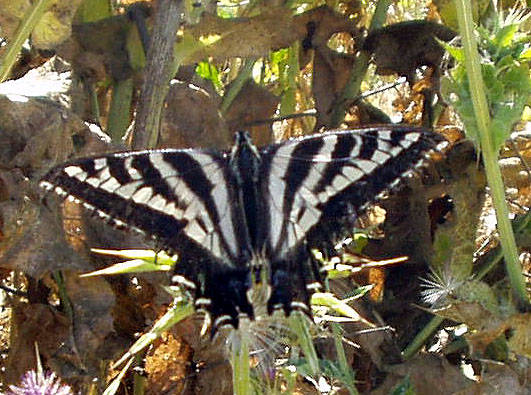 As you've probably guessed by now, I like to take pictures when I'm out geocaching. I don't necessarily take pictures every time I geocache, but when there's a hike involved, I'll usually have my camera along with me. One of my favorite subjects to take pictures of are butterflies.
As you've probably guessed by now, I like to take pictures when I'm out geocaching. I don't necessarily take pictures every time I geocache, but when there's a hike involved, I'll usually have my camera along with me. One of my favorite subjects to take pictures of are butterflies.
I guess you could say I'm an amateur lepidopterologist. When I see a butterfly in the field, I usually watch it for several minutes in the hopes that it will alight somewhere and pose for me so I can take a picture of it. As a youngster, I can remember watching small yellow butterflies that were very common around my house. I had been told that these particular ones were moths, but I have since learned they are actually a type of skipper.
Since I had only seen these types of insects during the day, it made sense for them to be butterflies, as they are usually active during the day, while moths tend to be active at night. And that makes it nice to take pictures of butterflies, because they're out when I'm out. Back in December, I wrote about one of the Monarch wintering grounds near Pismo Beach, California. I can honestly say I've never seen so many Monarchs in one place ever.
I can remember growing up, reading about the Monarch butterfly and thinking if I'd ever get the chance to see one.  Living in California, I had a good chance, but the opportunity never seemed to arise and I figured it was going to be one of those elusive creatures that I would never get to see except at a laboratory specimen. Then, one year while on our annual summer camping trip, I spotted one in Kings Canyon National Park in Zumwalt Meadows along a nature trail. I have seen many Monarchs since then, including one while out hiding my latest cache.
Living in California, I had a good chance, but the opportunity never seemed to arise and I figured it was going to be one of those elusive creatures that I would never get to see except at a laboratory specimen. Then, one year while on our annual summer camping trip, I spotted one in Kings Canyon National Park in Zumwalt Meadows along a nature trail. I have seen many Monarchs since then, including one while out hiding my latest cache.
The interesting thing about butterfly identification is it's not an exact science. I tend to use this site as my guide when I'm trying to identify a butterfly. When I saw the Western Checkerspot on a trail hike last month, I was surprised to find that it could have been one of about four different subspecies.
There was another time while doing the Groundspeak series of caches when I spotted a pretty small green butterfly. It was late in the evening, so it was looking for a spot to rest of up for the night. When it found a spot, it folded up its wings and settled in. That didn't help with the identification, since much of the identity of a butterfly is on its top wings. The best I could do with that one was to narrow it down to either a Desert Marble or perhaps a California Marble. Once again, the identification guide is not fool proof, but it gave me a pretty good idea of what I was looking at.
These pictures here represent just a small portion of the butterflies I've seen in my lifetime. I have not been able to photograph them all, nor will I ever. I just think they're interesting to look at and I find it kind of neat to be able to note that the swallowtail isn't just a swallowtail, but a Pale Swallowtail.
Pictures were taken at or near the following geocaches:
East Canyon Above and Beyond the Meadow - by SnakeSpotter
Micro N Post - by not tom
Carpe Diem! - by HaZaMaTt...
Thursday, June 24, 2010
Butterflies are free to fly
Posted by
Paul Myers
at
10:27 AM
Labels: fauna, geocaching, Ribbit
Subscribe to:
Post Comments (Atom)

1 comment:
When you posted this, we were obn vacation, and wouldn't be home for another two weeks, so I'm late to get to this one. I *do* read every one of these blogs, no matter who writes them, but it can take a while to get around to them.
In any event, that key you posted a link to is great! I bookmarked it, and will certainly use it. I use a Peterson field guide most of the time, but it can take a while to narrow things down. Having taken Field Botany in college, I'm use to using keys like that, and I think it will be of great help. Thanks!
BTW: I share your enjoyment of photographing flutterbys, although I enjoy taking pictures of flowers a little more, possibly because they don't move, except in a breeze ;-)
Post a Comment